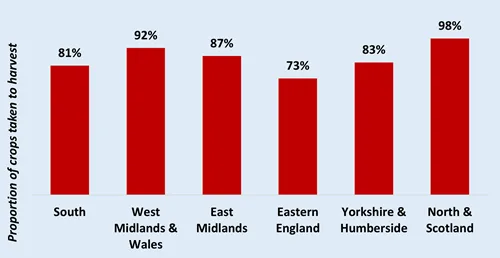
The 2023 winter oilseed rape crop is shaping-up to be very decent in most parts of the country, according to the fourth in Bayer’s annual Dekalb benchmarking studies.
Author
| 1st June 2023Latest OSR Benchmarking Suggests ‘Very Decent’ National Crop
The 2023 winter oilseed rape crop is shaping-up to be very decent in most parts of the country, according to the fourth in Bayer’s annual Dekalb benchmarking studies.
Responses from over 180 growers well spread across the main OSR growing regions and responsible for nearly 20,000ha of plantings shows an encouragingly high level of crop success and condition going into flowering. Especially so considering noticeably higher cabbage stem flea beetle pressures and more challenging sowing and winter conditions than the past two seasons.
“Almost 20% of growers reported an intense or substantial CSFB challenge last autumn and around 30% little or no challenge,” explains Dekalb trials and technical manager, Richard Williams. “This level of pressure was higher than recent years but much less than 2019 when over 50% saw particular challenges from flea beetle.
“A bone-dry August didn’t make things any easier for many and halted the major swing to earlier drilling we’ve recorded since 2019. Even so, at an average 7.1 out of 10, crop establishment was rated only slightly lower than last season’s 7.4, with fully 80% of the planted area scored at 7.0 or more.
“The rather colder winter with periods of very wet weather saw particular plant losses, pigeon damage and poor early spring growth & development,” he continues. “Unsurprisingly too, flea beetle larval levels were also higher this spring.
“The net result was a reduction in crop condition before flowering – which we scored for the first time this year – to 6.7 out of 10, with only 60% of the area rated at 7.0 or more. Overall, the 85% of sowings being taken to harvest is a little lower than either 2020/21 or 2021/22. Having said that, it’s well above the 61% recorded in our 2019/20 study (Figure 1). “All-in-all then, we have a very decent crop, considering the season.”
Figure 1: OSR Crop Survival – 2019/20 to 2022/23

Considerable Regional Variation
Naturally, the national position hides considerable variation between the regions, with the north and west of the country faring noticeably better than the east (Figure 2).
Figure 2: Regional OSR Crop Survival (2022/23)

With generally better moisture conditions and lower CSFB pressures, growers in the North & Scotland continue to report the best crops in almost every respect – better establishment, lower CSFB larval levels, higher mid-February GAIs and better crop condition going into flowering. Unlike every other region, indeed, they are taking a higher proportion of their plantings – 98% on average – to harvest this season than last.
Growers in the West Midland & Wales are also doing better than the average in all the key areas of crop success and taking more than 90% of their plantings to harvest – albeit slightly less than they did last season.
“Crop experience in the South, East Midlands and Yorkshire & Humberside is very similar to the national average, with southern growers taking a rather lower proportion of their plantings to harvest than those in the East Midlands but in somewhat better condition,” reports Mr Williams.
“The lowest levels of crop survival and the poorest crops going into flowering are definitely in Eastern England, with Yorkshire & Humberside also experiencing noticeably poorer crop condition at flowering than the average.
“The 73% of plantings being taken to harvest in the East is well down on last season’s 90% and pre-flowering crop condition averaged just 3.2 out of 10. This is particularly concerning for harvest in the region.”
CSFB Pressure the Key
Other than September sowings, all measures of crop success varied relatively little with time of drilling, despite increasing levels of CSFB pressure as the sowing season progressed.
In addition to a noticeably lower establishment score, mid-February GAI and condition going into flowering, crops sown in September had a similar level of CSFB larvae to the earliest plantings. This may reflect more extended adult emergence and activity than generally assumed in an open autumn.
Rather higher levels of winter plant loss and damage from winter stem weevil added to the greater pressure from flea beetle larvae, resulting in only 74% of September plantings being taken to harvest against between 87% and 91% of earlier sowings.
“Likewise, only the driest conditions at sowing and least rainfall during establishment had much of an effect on crop success,” Mr Williams notes. “In contrast, the degree of autumn CSFB pressure remains responsible for greater differences than any other factor (Figure 3).
Figure 3: Crop Success by CSFB Pressure (2022/23)

* Crop establishment(0=crop lost:10= perfect establishment)Larval level (0=no larvae or scar: 10=more than 30 larvae/plant or multiple scars on all petioles & stems)
GAI (Actual score) Crop condition (0=very poor: 10=excellent)
“Just 71% of crops under intense or substantial early pressure from the pest are being taken through to harvest, against 90% of those seeing little or no pressure at establishment.
“The fact that higher adult CSFB pressures were also associated with more reports of serious winter plant losses, poorer early spring growth & development and significant stem weevil damage underlines the wider impact of the pest,” he stresses. “Beyond their initial effect on establishment and later larval damage, flea beetle infestations clearly make the crop more susceptible to other problems over the winter.”
We Highly Recommend:
Expertise & Establishment support

Bayer CTMs are on-hand to work with growers and agronomists to support variety selection, working together to best achieve your goals. In additional support, the DEKALB OSR establishment scheme is here to provide extra reassurance to growers in challenging times. All Dekalb varieties have strong development characteristics, helping them grow away from establishment challenges, however, should your crop fail due to flea beetle or other pressures, you’ll be credited by your seed supplier with £100/bag.